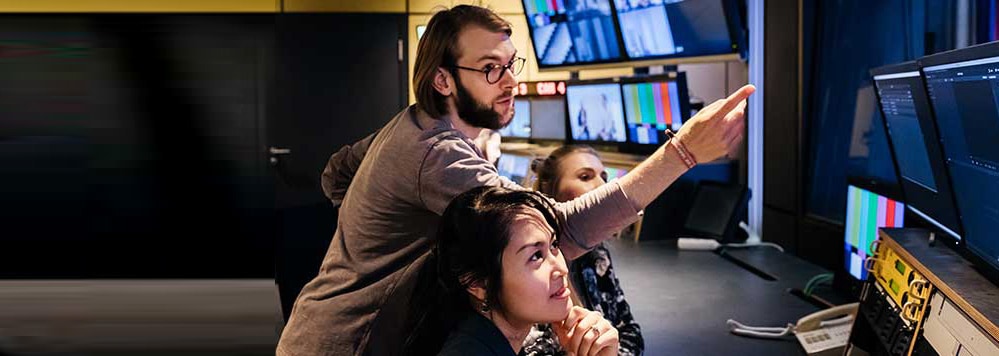Media businesses are going to need to come up with inventive ways to make the most of their current catalog as social distancing restrictions put a stop to filming, sports and public events. To retain viewers and advertising revenue, they must adopt digital media platforms and artificial intelligence. These will enable them to speed up the creation of more content globally using the existing catalog and add snackable, targeted content based on viewer preferences.
Supply down, competition up
The demand for home-viewed content has never been higher. Media consumption during the COVID-19 pandemic has increased. GlobalWebIndex found that 87% of U.S. consumers and 80% of U.K. consumers have been consuming more content since the outbreak began.1 The primary media are broadcast TV, online TV-streaming and online videos.
In many industries, content production requires physical human interaction. For the music, film and TV industries, these times are particularly difficult. New productions are currently on hold because of closed central studios. Sports and live events have also stopped, removing any chance to generate new content for their audiences.
While these traditional types of content are struggling, digital-first content is thriving. Game producers continue to develop games and new add-ons while working from home. Podcast creators, bloggers and social talent also don’t have issues with remote working. In fact, independent production of content in general has good conditions to survive today’s crisis. For example, user-generated content on platforms such as YouTube, TikTok and IGTV is booming and rapidly gaining popularity. TikTok itself has 800 million monthly active users and the highest social media engagement rates per post.2
All this creates competition and boosts digital media. To retain their consumers, content providers need to meet higher expectations from an increasingly digital-first audience.
For the most part, this will require music, film, TV, sports and live entertainment producers to focus on generating new value from their existing content, either by repurposing or reframing the audience’s interactions with it. It will also involve looking into “long tail” opportunities, such as republishing archive footage or purchasing foreign content.
Content providers need to meet higher expectations to retain their customers
To do this effectively and securely and to maximize revenue opportunities, media companies must consider migrating to a holistic digital platform. Without this, there will be many struggles to overcome.
Digital deficit and piracy
The pandemic has exposed holes in the operational capabilities of the media industry. In simple words, handling production remotely is hard and also prone to piracy.
Productions on-set and on-location and studio post-production usually require physical interactions between digital dailies, editing, visual effects and other functions. Although post-production and visual effects teams are less dependent on physical interactions, moving to remote working has its own implications. Those who are used to working in central studios now share access to rushes and content. This leads to multiple hops of content across various units for content enrichment, with each unit handling its own security in its own way.
Piracy can occur throughout the entire media production cycle. When the content is being transferred across networks, the risk of someone stealing it increases. Inevitably, working from home creates more vulnerabilities as home networks are far less secure than corporate networks. This also leads to increased cybersecurity risks.
Metadata and insights
Media businesses can reuse old production assets or tap into foreign films. However, this introduces additional work. It requires various post-production and distribution activities, such as multilanguage dubbing, creation of global and local metadata, creation of a video library and indexing. The asset management process is extremely hard and inefficient, which makes asset traceability and reuse challenging.
The same applies to sports and the live entertainment industry. Most of the time, event highlights, key moments and related statistics are captured at the end of a sporting event or a live concert — when rich context is forgotten. The problem is that content generation is not coordinated across the production supply chain. Its generation is manually laborious and locked into the vendors. Furthermore, the current solutions are incapable of automatically collecting all the relevant data points (metadata, statistics) across languages and country variants during the production process. They are a part of post-production activities.
Metadata and related insights have a significant impact on sales, marketing and distribution. The lack of coordination is an existing problem that has been amplified by the pandemic. With most of the world connecting remotely, it has become more challenging.
Monetization and advertising
Most of the media industry relies heavily on advertising revenue, and advertising revenue depends on economic stability and consumer spending. Because of the pandemic, economists predict a recession in the second half of 2020. This will affect advertising spend.
Prior to COVID-19, there was a major push to create unified linear and digital audiences. In normal times, during the TV upfronts, all the major broadcasters come together to fix their inventory to agencies and media buyers. Under the new circumstances, all this has vanished.
Although many TV upfront events have to go digital, there are no clear plans. As a result,3 there is a major shift from what was a prime-time broadcast inventory to things that might be featured directly in digital. This can also negatively impact sales.
Now when consumers have more free time, they watch more television. Rising audience ratings benefit television advertisers. But because companies have less money to spend on advertising, the increase in audience itself will not be enough to offset the costs.
To increase revenues, ads will need to be more targeted than ever before. Companies must focus on optimizing their ad inventories based on consumption. For instance, right now advertising a brand of toilet paper is more relevant than promoting a new Tesla car. With optimization of inventories, the ads can be monetized more effectively.
To further complicate matters, retaining viewers and advertising revenue gets harder because of multiple similar offerings. Monetization is also hard because of evolving and ever-changing customer expectations. On top of that, advertising sales for linear (in-sequence), digital and affiliate media brands are siloed. And because TV upfront events have to go digital and advertising is canceled this year, the TV show and inventory-based media buying process has a significant limitation.
Case study
The film industry
The film industry relies heavily on box office sales but is now leveraging over-the-top platforms in a more aggressive manner. For example, Universal Studios has postponed the theatrical release of the Fast & Furious sequel, but it has released “The Invisible Man,” “The Hunt” and “Trolls World Tour” online.4 While some of the big media conglomerates are testing new distribution models, they still pushed back their biggest productions. The decision to postpone releases exposes global film studios to two significant costs: the production costs and early marketing spending costs. To make a film, the studios spend hundreds of millions of dollars. For example, the budget of MGM’s latest James Bond film, “No Time to Die,” is estimated to be $250 million.5 Since the coronavirus outbreak, it has been pushed back twice, and the new release date is Nov. 25. Studios will now have to absorb any early marketing spending, and when the movies are released, revenue levels will not be attained as expected.
Steps to consider beyond COVID-19
The current crisis has hit the media industry hard. The demand for entertaining content has spiked, but the creation of new content is limited. World-famous film studios are pushing back releases of their new movies to the end of 2020 or even 2021. The inability to record content in the first half of the year to be distributed in the second half will create gaps in schedules. These delays create problems with revenues. For smaller studios, these times are particularly challenging.
Using data-driven content personalization to generate new content
Studios can reuse old production assets in new productions already in flight and look into their long-tail and foreign films. They can create different types of movies, produce alternative endings or introduce visual effects to modify old content. To do that they will need to use data-driven content personalization, which will solve the existing metadata coordination problem.
If metadata is collected and coordinated effectively, it has the potential to provide fans with unique details. It can enable them to perform a content-based search to stop a movie at their favorite scene and look into its backstory. With metadata, fans can learn the reasons why the director has made certain decisions. They can pause their favorite scenes and see the scenes in details, actors, and scripts. Sports fans can rewatch their favorite game moments, learning more about the tactics used, and snack on the trivia and insights for a more engaging experience.
Artificial intelligence removes the need for humans to create metadata. By having efficient search capability, automatic metadata generation can trace to old production assets and reviews and filter the content by parameters. It can then link them into the editorial workflow.
Moreover, there is a big interest in all streaming platforms to bring in international content or distribute their content internationally. This requires localization and market-specific enrichment metadata. AI-driven automatic metadata generation and real-time, snackable content creation are scalable for global language and territorial variants at every stage of production. This will speed up the process of looking at the existing footage and identifying what can be reused.
Virtual studios powered by a cloud-based, centrally orchestrated platform
The more digitized and automated the processes become, the more abilities producers will have to better manage metadata to create more assets to use remotely.
For this they will need to consider adopting a virtual studio model. It is already evident that having a physical studio-centric, human-effort intensive and distributed supply chain is complex and not adaptable to current circumstances. It slows down the production process and poses vulnerabilities. By moving their production supply chain to the cloud, studios can reduce or completely eliminate the need for an on-site staff presence. Post-production teams will be able to fulfill their functions (video and audio editing, visual effects, content mastering, and distribution) completely remotely.
Virtual studios are also secure. Production companies can eliminate piracy risks by storing their assets in a centralized repository of content, the access to which will be managed based on a principle of privileges, e.g., the person who needs to work on sound will be able to do so but will have no rights to download the content.
Monetizing releases and optimizing ad inventories
To monetize releases and other elements, companies need to unify advertising sales leveraging customer 360-degree analysis. To do that, they need to unify the audience data across linear, digital, first-party, ad engagement, social and third-party data, which today exist in silos. Instead of going through the inventory show-based approach (which most broadcasters would have done during the upfront season), broadcasters need to base the data on audience silos. Second, ad inventories need to be optimized based on consumption. Broadcasters already have it at their disposal; they just need to start rolling out these initiatives.
Keeping audiences engaged through AI-based video analytics and processing
The coronavirus has caused fundamental changes to sports and live-events industries. It is possible that post-crisis, some events will be fully transformed into “studio events” with empty venues. To adapt to new conditions, businesses need to consider deploying virtual and augmented reality. This will help them retain their fan base by bringing events into viewers’ homes.
AI-based video analytics and processing capabilities can help generate additional content to provide a more engaged and richer fan experience, even at home. AI can overcome sports production limitations and personalize the sports fan experience. Fans can have personalized game plays available on any TV streaming platform, on any device.
Using existing content, AI can keep audiences engaged by creating snackable content. It can generate highlights of past games or live events based on user preference. For example, it can create a highlight of best moments and scenes of a user’s favorite famous personality. To make the content even more engaging, AI can leverage statistics and interesting facts. It can also generate multiple view angles for every game play or a condensed 30-minute view mode. Lastly, with the use of VR technologies, users can be submerged into fantasy play.
Digital platform and AI-based analytics and processing will help businesses to adapt to new conditions
To ensure that attending a live event will be an overall pleasant and engaging experience, real-time video analytics can manage crowds with timely alerts, e.g., waiting time for lines or food and beverage availability.
Going digital, being resilient
The emerging content creation crunch is going to force production companies to rethink the way they plan, create, manage and monetize their content assets and work with their production partners. As in so many industries, the COVID-19 crisis is accelerating digital trends that had already been emerging. The time is now for production companies to fully embrace a digital production platform so they can empower their talent, producers and delivery partners in this time of crisis.
Of course, migrating to a new platform requires overcoming significant cultural, process and technical challenges. Yet the current crisis has created a window of opportunity for change and a significant incentive to take this journey. Those who shy away from a true digital transformation will find themselves left behind when the audience is released from lockdown into a new normal.
References
- “Contingency Planning: Where Should Brands Be Moving Their Ad Spend?”, GlobalWebIndex, April 2020
- “50 TikTok Statistics That Will Blow Your Mind,” Influencer Marketing Hub, April 2020
- “Upfronts,” The Hollywood Reporter, 2020
- “Universal Pictures Is Releasing Its Current Movies Online Because of Coronavirus,” QUARTZ, March 2020
- “No Time to Die,” IMDB, 2020





